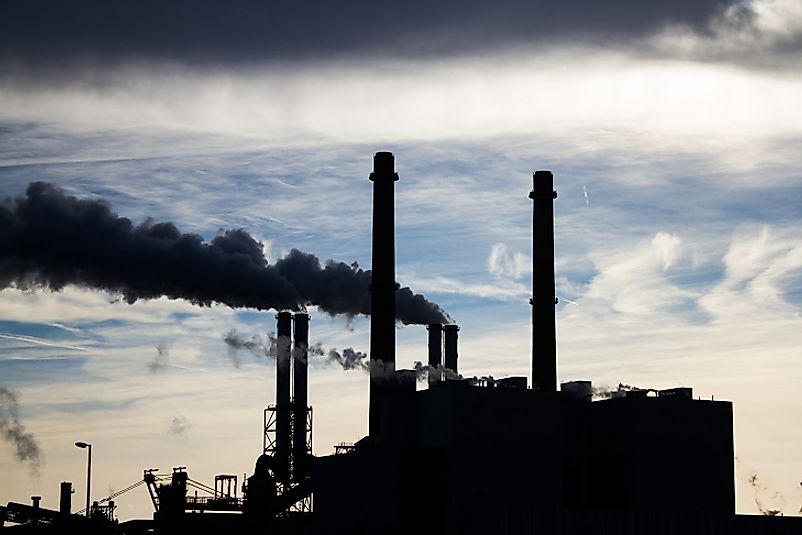US Greenhouse Gas Emissions

Greenhouse gases include carbon dioxide, methane, nitrous oxide, and fluorinated gases. These gases collect in the earth’s atmosphere and absorb solar radiation. In the greenhouse effect process, part of the radiation is released back into the atmosphere where it is trapped, thus warming the earth’s surface. In moderate amounts, greenhouse gases are necessary to maintain livable temperatures. Without them, the earth’s surface would be freezing everywhere. An excess of greenhouse gases, however, contributes to global warming. Global warming changes weather patterns and leads to increased storm activity, melting ice caps, and rising sea levels which have negative consequences on ecosystems and biodiversity all over the world. Being an industrialized country, the US emits large quantities of these gases every year.
US Greenhouse Gas Emissions
Carbon Dioxide
Of all the greenhouse gas emissions by the US, carbon dioxide makes up the largest share at 81%. Where does carbon dioxide originate? The biggest contributor of this gas in the US is from burning fossil fuels. Fossil fuels are nonrenewable energy sources created millions of years ago and include substances such as coal, oil, and natural gas. People and industries use them to create electricity, run transportation, and manufacture goods. When naturally present in the air, plants consume carbon dioxide and create oxygen but human activity has altered this natural process. With deforestation practices, less trees are able to consume the gas which results in increased levels in the atmosphere.
Methane
The second highest gas emitted in the US is methane, 11% of total greenhouse gas emissions. Methane is another naturally occurring gas that leaks out of wetlands and is absorbed by soil and chemical reactions in the atmosphere. While all greenhouse gases trap solar radiation, methane traps significantly more than carbon dioxide. Natural gas is comprised of methane and its production and use lead to emissions. Another industry that produces methane is livestock production, particularly on factory farms. The animal waste is collected in pools and artificial lakes (what does not leak into groundwater) where it sits and produces methane.
Nitrous Oxide
Nitrous oxide makes up 6% of US greenhouse gas emissions and as with the previously mentioned gases, it is also naturally occurring. What makes this gas dangerous is that human activity has increased its presence in the atmosphere where it will stay for 114 years. After a little more than a century of contributing to global warming, the molecules will be broken down by atmospheric reactions. One pound of nitrous oxide is equivalent to 300 pounds of carbon dioxide. The agricultural industry is responsible for a large percentage of nitrous oxide emissions because of the nitrogen that is added to soil as fertilizer.
F-Gases
Fluorinated gases, or F-gases, make up 3% of all greenhouse gas emissions. This is the only gas on the list that comes from human activity and does not occur naturally. Small concentrations of F-gases have large effects on the atmosphere and last for thousands of years. These gases are used as refrigerants, solvents, and fire retardants. Industrial processes involving aluminum and semiconductors produce F-gases as well.
Reducing Emissions in America
Although these gases are emitted by activity in the US, they do not stay in the atmosphere over this country. Instead, they are transported throughout the world. This means the US has a global responsibility for reducing emissions. The Environmental Protection Agency (EPA) collects data in regards to the effects of and amounts of greenhouse gases in the atmosphere to inform the country’s policy makers and businesses. In addition, the agency is working to reduce gas emissions through regulatory initiatives such as the Clean Air Act, the Clean Water Act, and the Clean Power Plan, as well as by partnering with private industry to guide energy efficiency in these companies. The EPA also reaches out to international entities and state and local administrations to provide the resources needed to ensure climate-friendly endeavors.
US Greenhouse Gas Emissions
| Rank | Greenhouse Gas | Percentage of total greenhouse gas emission (Total Emissions in 2014 = 6,870 Million Metric Tons of CO2 equivalent) |
|---|---|---|
| 1 | Carbon-dioxide | 81% |
| 2 | Methane | 11% |
| 3 | Nitrous Oxide | 6% |
| 4 | Fluorinated gasses | 3% |











